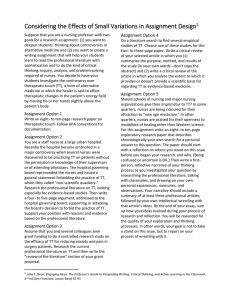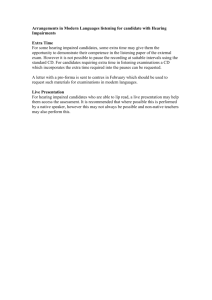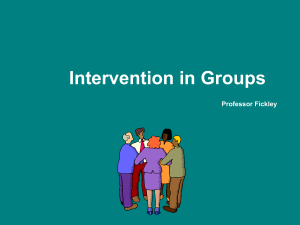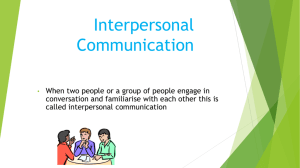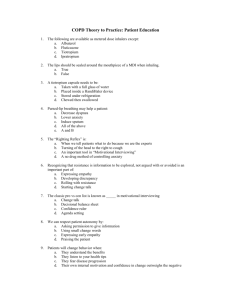Lecture #2 Communication
advertisement
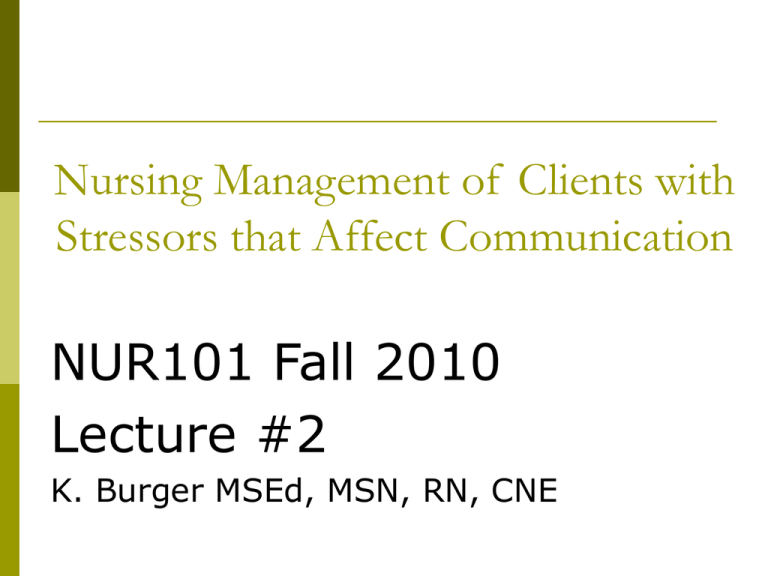
Nursing Management of Clients with Stressors that Affect Communication NUR101 Fall 2010 Lecture #2 K. Burger MSEd, MSN, RN, CNE Therapeutic Communication Different from Social Communication Foundation of Nurse-Client Relationship Planned Directed toward a goal Client-focused Information sharing is unequal Nurse guides the conversation Elements of Communication Source (encoder) Message Channel- Auditory , Visual, Touch Receiver (decoder) Feedback Nurses Role Therapeutic communication Helping relationship between nurse and patient Utilizes interviewing techniques to gather information (assessing) PHASES of HELPING RELATIONSHIP Orientation Working Termination Factors that Influence Communication Developmental Stage Gender Sociocultural Role/Occupation Time & Setting Personal Space Physical Ability Mental State Emotional State Effective Communication Starts with unconditional acceptance of client and a nonjudgmental attitude Friendliness, openness, respect Empathy, trust, caring, competence Purpose, privacy, confidentiality, comfortable environment, personal space Verbal Communication Transmitting a message using the spoken or written word Nurses speaking to patients/ nurses/doctors or writing progress notes/ nursing care plans Nonverbal Communication Transmission without using words - gestures Body language Touch Eye contact Facial expressions Posture Gait Physical appearance Dressing/grooming Sounds Silence Techniques Facilitating Communication Conversational skills-See Handout Tone of voice Knowledgeable Confidence Flexible Clear/Concise Avoid semantics Listening skills Alert/relaxed Indicate attentiveness Think before you speak Listen for themes Honesty/Authenticity Facilitating Communication Silence Touch Eye contact Watch your body language Humor Assertive Utilize opportunities Use of supportive statements Displaying empathy Blockers to Communication Not perceiving pt. as a human Not listening Changing the subject False reassurance Being judgmental Inappropriate comments Clichés Asking yes/no questions Giving advice Probing questions See Handout Interviewing Techniques Used by nurses to obtain information about pt. Useful in the helping relationship FIRST STEP = attentive listening!!! ALSO NEED: privacy, comfortable environment Open ended questions “What brings you to the clinic today?” Closed questions/comments – yes/no Validating questions/comments “Tell me whether my understanding of what you said is correct…..” Interviewing Techniques Clarifying questions/comments Used often in therapeutic communication Reflective (re-stating) questions/comments – use sparingly Paraphrasing Also conveys attentive listening Direct questions Good for history taking Sequencing – helps with determining cause effect relationships Re-focusing Guides conversation back to goal AN EXAMPLE During your shift in the ICU you have been assigned to care for a man injured in a motor vehicle accident in which he has been charged with DWI. The driver of the other car was killed. The patient says to you: “I feel so terrible about what has happened” Clarifying “ARE YOU FEELING BAD ABOUT HAVING BEEN DRINKING AND DRIVING?” “ARE YOU FEELING BAD ABOUT HAVING KILLED SOMEONE?” “ARE YOU FEELING TERRIBLE ABOUT YOUR INJURIES?” “ARE YOU FEELING TERRIBLE ABOUT THE FACT THAT YOU ARE GOING TO BE ARRESTED AND GO TO JAIL?” CONVEYING EMPATHY USING CONGRUENT NON-VERBAL COMMUNICATION TECHNIQUES: TOUCH EYE CONTACT SILENCE ALONG WITH: SUPPORTIVE STATEMENTS Impaired Communication Hearing impaired Visually impaired Language barriers Physical barriers Cognitively impaired Unconscious SEE P&P p.1358 Box 49-9 Communicating with Healthcare Team Members Exchange of patient information between healthcare givers must be efficient, precise, and complete. JCAHO Goal 2 of 2007 Patient Safety Goals: “Implement a standardized approach to “handoff” communications, including an opportunity to ask and respond to questions” SBAR S B A R Situation Background Assessment Recommendation Can be used when: Reporting patient condition to physician Change of shift reports Transfer to another unit or facility SBAR Example: A call to a physician Dr. Jones, this is Deb McDonald RN, I am calling from ABC Hospital about your patient Jane Smith. Situation: Here's the situation: Mrs. Smith is having increasing dyspnea and is complaining of chest pain. Background: She is 2 days post-op total knee replacement. About two hours ago she began complaining of chest pain. Her pulse is 120, blood pressure 128/54 and she is restless and short of breath. Assessment: My assessment of the situation is that she may be having a cardiac event or a pulmonary embolism. Recommendation: I recommend that you see her immediately and that we start her on 02 stat. Using SBAR for Change of Shift Report


